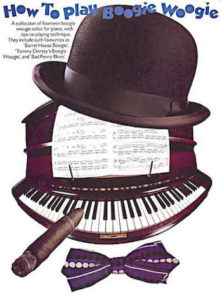
*Boogie-woogie music and Black History are celebrated on this date in 1870.
This blues music genre was developed in American Black communities in the 1870s and became popular during the late 1920s. It was eventually extended from piano-to-piano duo and trio, guitar, big band, country and western music, and gospel. While standard blues traditionally expresses various emotions, boogie-woogie is mainly associated with dancing.
A regular left-hand bass figure characterizes Boogie-woogie, transposed following the chord changes. Boogie-woogie is not strictly a solo piano style; it can accompany singers and be featured in orchestras and small combos. It is sometimes called "eight to the bar," as much of it is written in standard time (44) time using eighth notes (quavers) (see time signature). The chord progressions are typically based on I–IV–V–I (with many formal variations, such as I/i–IV/iv–v/I, and chords that lead into these). Mostly, boogie-woogie tunes are twelve-bar blues, although the style has been applied to popular songs such as "Swanee River" and hymns such as "Just a Closer Walk with Thee."
Several African terms have been suggested as having some interesting linguistic precursors to "boogie": Among them are the Hausa word "Boog" and the Mandingo word "Booga" (both of which mean "to beat," as in beating a drum), West African word "Bogi" (which means "to dance") and Bantu term "Mbuki Mvuki" (Mbuki: "to take off in flight"; Mvuki: "to dance wildly, as if to shake off one's clothes"). The African origin of these terms is consistent with the Black origin of the music.
As a fad, Boogie-Woogie lasted from the late 1930s into the early 1950s. It significantly contributed to the development of jump blues and, ultimately, to rock and roll, epitomized by Fats Domino, Little Richard, and Jerry Lee Lewis. Louis Jordan is a famous jump-blues musician. Boogie-woogie is still heard in clubs and on records throughout Europe and North America. Big Joe Duskin displayed on his 1979 album, Cincinnati Stomp, a command of piano blues and boogie-woogie, which he had absorbed first-hand in the 1940s from Albert Ammons and Pete Johnson.
The trickle of what was initially called hillbilly boogie, or Okie boogie (later renamed country boogie), became a flood around late 1945. One notable country boogie song from this period was the Delmore Brothers' "Freight Train Boogie." More representative examples can be found in some of the songs of Western swing pioneer Bob Wills. The hillbilly boogie period lasted into the 1950s; Tennessee Ernie Ford made the last recordings of this era with Cliffie Stone and his orchestra with the guitar duo Jimmy Bryant and Speedy West. Bill Haley and the Saddlemen recorded "Sundown Boogie" in 1952, again featuring the guitar playing the boogie-woogie rhythm.
Boogie-woogie continued in country music through the end of the 20th century. The Charlie Daniels Band (whose earlier tune "The South's Gonna Do It Again" uses boogie-woogie influences) released "Boogie Woogie Fiddle Country Blues" in 1988, and three years later, in 1991, Brooks & Dunn had a massive hit with "Boot Scootin' Boogie." In addition, some tradition-minded country artists, such as Asleep at the Wheel, Merle Haggard, and George Strait, incorporated boogie-woogie in their recordings.
In the many styles of blues, especially Chicago blues and (more recently) West Coast blues, some pianists and guitarists were influenced by and employed the traditional boogie-woogie styles. Some of the earliest and most influential were Big Maceo Merriweather and Sunnyland Slim. Otis Spann and Pinetop Perkins, two of the best-known blues pianists, are heavily boogie-woogie influenced, with the latter taking both his name and signature tune from Pinetop Smith. In Western classical music, the composer Conlon Nancarrow was also profoundly influenced by boogie-woogie, as many of his early works for player piano demonstrate. "A Wonderful Time Up There" is a boogie-woogie gospel song. In 1943, Morton Gould composed Boogie-Woogie Etude for classical pianist José Iturbi, who premiered and recorded it that year. Povel Ramel's first hit in 1944 was Johansson's boogie-woogie-vals, where he mixed boogie-woogie with a waltz.
21st-century commentators have also noted the characteristics of boogie-woogie in the third variation of the second movement of Ludwig van Beethoven's Piano Sonata No. 32, written between 1821 and 1822. This genre of African music survived the middle passage to thrive and show the intersectionality of Black art with many other colors, cultures, and nationalities worldwide.